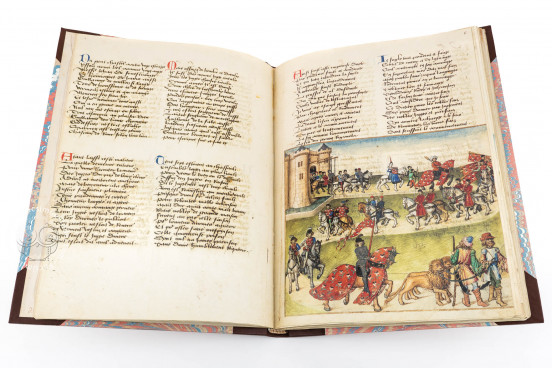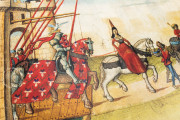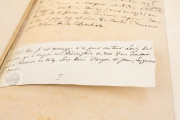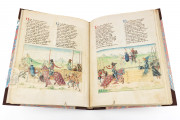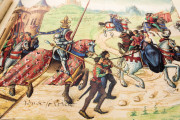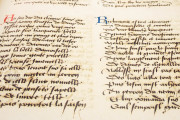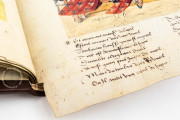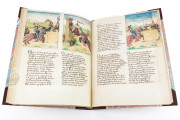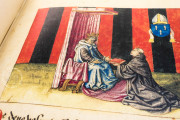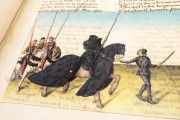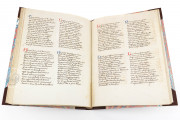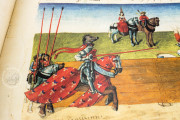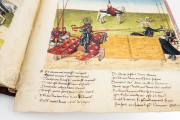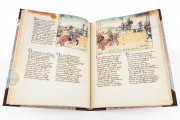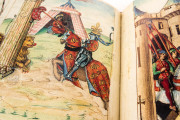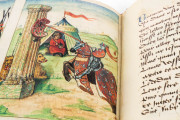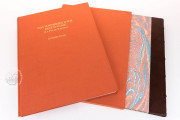One of the most precious manuscripts now kept in the Russian National Library in Saint Petersburg is the Tournament Book of René d’Anjou, which is famous throughout the world for its remarkable contents and text. Produced in the 70s of the 15th century, the manuscript contains the only version ever known of a poetic description of the Pas de Saumur, a sumptuous joust festival that King René had organized for his knights at Saumur in the year 1446.
The codex encompasses 91 illustrations of great historic value, which fascinate by their momentum and a great feel for vivid detail. These masterfully executed pictures are based on the lost original drawings of Barthélemy d’Eyck, an excellent painter who was active for a long period at René’s court. The great value of the poem as a historic and literary monument of the 15th century and the undisputed rarity of the text have not only drawn the attention of researchers specialised in medieval history, literature and culture. The manuscript also offers a wealth of valuable material for studies in medieval heraldry, as the illustrations show a great number of coat of arms and crests.
The only testimony to the pas d’armes held at Saumur
The Saint Petersburg manuscript is the only historic testimony to the sumptuous knights’ festival organised in Saumur which put all other tournaments in the shade. It enables us to reconstruct the course of this solemn event in all detail. This very important aspect makes the manuscript an informative document on the history of the knightly mock battles of the late Middle Ages.
The author reports on the organisation and the ceremony of the joust (a kind of knightly mock battle in which only two knights at one time were allowed to charge each other), on actors and combatants; he describes the knightly equipment, especially the bascinets, as well as the harnesses and mantling worn by the combat horses. He goes even further and tries to present tournaments, which were obviously among the essential themes of the courtly and knightly culture, in their true significance.
René d’Anjou: a politician, patron and poet
René d’Anjou, king of Naples and Sicily, duke of Anjou, Bar and Lorraine, was one of the most generous tourneyers of his era. He was not only an ambitious sovereign but also an educated patron of the arts. Beyond that, he also tried his luck as a poet. Numerous works from his pen, among them the “Livre du Cuer d’Amours Espris”, a romantic allegory, bear testimony to the king’s talent for this genre among others. René also knew how to hold glorious festivals. The tournaments he arranged were famous throughout the country and sung by a great many poets.
A mirror of the knightly way of life
The organiser of the tournament, René himself, probably commissioned the Saint Petersburg manuscript. He hired a poet, whose name has been lost in the course of history, to write a poetic description of the sumptuous pas d’armes. However, out of all solemn events that took place there, the writer chose to describe only the combat scenes, with only a few exceptions. He was obviously less keen on the results of the competition than on an extensive description of the arms depicted on the shields, the horses’ harnesses, and the helmets worn by the participants.
This might be due to the king’s wish according to which each participant was to display his own heraldic device, the cuir bouilli, the crest and the coat of arms on his shield, and these instructions conferred the arms and helmets the greatest importance. The 3952 verses also contain statements concerning the significance of tournaments in the contemporary knightly society as well as indications to the codex of behaviour and honour to which every participant had to bow.
The ritualised combat was for the knights a means to demonstrate their ideals of life: braveness and generosity, honour and glory, fealty and courtly love. In this commission, the author reveals himself as a master of the poetic form used, keeping strictly to the verse structure and rhythm in each stanza. He appears to have been an enormously learned poet, well experienced in the making of a poetic text.
The miniatures
The narrative of the work is visually supported by numerous illustrations, whereby picture and text are closely related to each other. The illustrations are all drawn with a pen and then painted with water-colours. Differences in colour and the reproduction of landscapes as well as different representations of knights and their bascinets make us assume that the manuscript is the work of several hands. The miniatures often constitute a valuable addition to the text and one may say that the illustrated cycle as well as the text both determine the value of the work as a historic source to the same extent.
We have 1 facsimile edition of the manuscript "Tournement at Saumur": Das Turnierbuch für René d´Anjou facsimile edition, published by Akademische Druck- u. Verlagsanstalt (ADEVA), 1998
Request Info / Price
